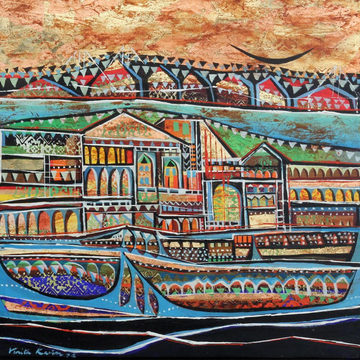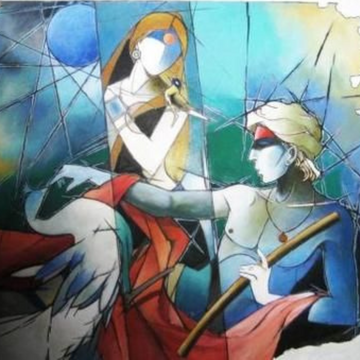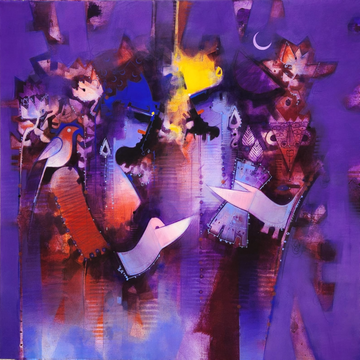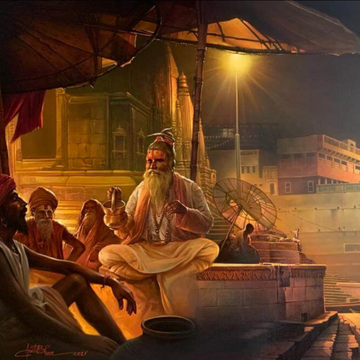The Quintessential Transcendence of Colors and Canvas: Vinita Karim’s Global-Indian Art

The tidal emergence and recession of indelible imprints permeating her subconscious; a kaleidoscopic wealth of observations amassed during her unmatched journey across the globe; a piece of each unique culture, every inimitable city, plucked by her perception as a revered souvenir, carving its enchanted niche among the exquisitely juxtaposed layers of the distinctive faces of the world, forms Vinita Karim’s secret potion for conjuring artistic magnificence. As a self-confessed colorist, if given enough colors to play with, Vinita can create art that stirs a unique resonance with each observer, revealing different facets of its intricate detailing to each individual as part of an ongoing interaction with her art that transcends the mere activity of witnessing the variegated dance on canvas.

Born on September 4, 1962, in Rangoon, the former capital city of Burma (now Myanmar) Vinita has lived a nomadic lifestyle across Europe and Asia. After graduating as a Bachelor of Science in Economics and Business Administration from the University of Stockholm, Sweden, she went on to pursue a Diploma in Fine Arts from the Gerlesborg Art Institute in Stockholm, Sweden. Subsequently, she lived in various countries – Germany, Switzerland, India and Egypt, before moving to Phillipines. Realizing that art was the true calling of her life, she completed her Masters in Fine Arts from the University of Phillipines with her thesis on the enthralling topic of Multicultural negotiations outside boundaries.
An Unparalleled Expedition
At the very inception of her art journey in the early 1990s, Vinita’s tools were watercolors, her subjects founded on the cheerful festivity of nature, birds, animals, water bodies, boats, balloons, etc., devoid of human figures and depicted in bright hues, her surroundings the ethereal natural beauty of Europe, and her audience the Swiss and Swedish men and women who relished her prismatic paintings and found a uniquely Indian touch defining her style.
The completion of Vinita’s first segment of art education in Sweden, where a lot of emphasis was on mastering the art of depiction of the human body, perfecting the portrayal of each physical curve, each facial expression, each shadow on the skin to lend a transcendental significance to the technicalities of the human anatomy, kick started her foray into the world of figurative painting in the late 1990s. Slowly, she transitioned to the inclusion of humans in her subjects with the watercolors being replaced by acrylics on canvas.

Vinita’s subsequent move to Egypt provided the ideal backdrop of a unique culture and philosophy, exhorting her to strive towards continuous innovation. As a result, she created a series of paintings depicting women in various forms, shades and environments, and framed their beauty with the inherent charms of old wooden windows, carved wooden screens and other artifacts that she discovered in the exotic locales around her. These were paintings whose splendor was not restricted to the physical boundary of the canvas.
However, even with the immensely fulfilling conception of such art pieces, a small part within Vinita still craved for abstraction in her work. Her experiments with gold leafs in Egypt, multiple painting media and the allure of decorated geometrical figures soaking her warm surroundings pressed her to occupy a place in her creations that were now leaning towards abstraction. She realized that, as it was time, once again, to move from Egypt to Philippines, an exploratory journey had to be undertaken in the vast world of abstract art too. Little did she know that this exploratory excursion would be the turning point in the discovery of her signature style.

As Vinita immersed herself more and more into abstracts, transitioning to extensive trails with oil paints, silver and gold foils, papyrus, parchments, etc. she discovered an incessant emergence of landscape elements in her art. Be it the deserts of Sahara or the many rivers of Bangladesh, her paintings pulled her towards a depiction of the various cities she had resided in. Simultaneously, around 2008-09, an expression of her own character as an artist, which was opposite to that of a minimalist, found its way through her brushes on canvas. It marked another departure from her earlier figurative work, imparting substance to her new abstract work.

The detailing took shape of architectural elements as the soul of the cities, layered between the infinite vastness of the sky and the deep roots of the ground. It was molded in various ornate forms and intricate designs to capture the core essence of different geographies. The resulting exquisiteness, in a way, was Vinita’s return to her deeply Indian roots and traditions of elaborate artistic decorations, a circling back to her native style, creating an unparalleled conjunction of a global flavor merging seamlessly into Indian traces.
The Boundless Muse
A perennially rapacious curiosity enabled Vinita to delve into various local art forms and traditional techniques, which rejuvenated her inspiration at every stage of her sojourn and found their integration with her style in the most pleasing way. Be it her tryst with Arabic calligraphy or the fascination with Tanjore paintings during her stay in Madras, she absorbed, transformed and continually created. Among the artists who deeply influenced her were K. M. Adimoolam in Chennai - well known for his Indian abstract art, Friedensreich Hundertwasser – an Austrian artist and architect whose paintings bore a major effect of color, and Mark Rothko – a renowned American abstract expressionist of Russian Jewish descent.

After Vinita settled in Dhaka in 2010, a whole new world of creativities opened up to her. The local handicrafts and textile arts, especially the meticulously elegant embroidery on muslin cloth captured her attention. She immediately resolved to make a place for them in her art. She started designing patches replete with geometrical symmetry, arched styles, colored boats, etc., got them embroidered from the local artisans and finally stitched them onto her canvas, adding another realm of dazzle to her paintings.
An ardent observer of her surroundings and always on the lookout for rare items, Vinita also started extending her trademark painting style onto objects found in the depths of foreign markets. She replicated an even greater magic in three dimensions, creating various series of sculptures on egg shaped fiberglass, wooden animal figurines from galloping horses to roaring cheetahs, etc.
The Voice of Colors
A deeply moving symbolism has always played a pivotal role in Vinita’s art, imparting voice to the silent strokes of brushes and opulent swathes of paint. Water bodies, riverbanks, seashores and boats have underlined many of her paintings. For her, boats are a metaphor of life; agents of change that allow a person to reach new shores and sail through the occasional turbulence in one’s path. Water bodies like rivers and lakes are vast, peaceful expressions of nature, exemplifying the need for complete immersion in one’s duty in life. Their minimalistic expansiveness also provides a visually exhilarating contrast with the brimming sense of human settlement on land conveyed through the intricately designed architectural elements. Such has been Vinita’s gravitation towards water bodies that she held a special show titled ‘River Stories’ in Dhaka.

Even though Vinita’s imaginative cities translate on canvas without any specific portrayal of humans, they still instill a sense of warmth, derived from an abundance of life, in the observer. This might be one of the reasons why her style fits so well on sculptures too. The ‘egg’ series of sculptures were not just beautiful shapes with ravishing colors, but also represented the transition from womanhood to motherhood, the greatest process of creation of new life. Similarly, a carousel with horses was one of her art pieces that appealed to the joyful childhood memories in the viewer.
Having left her immensely successful mark on the art world, Vinita feels that her journey and evolution are ongoing processes. Currently, she is working on a new series of sculptures involving horses with wings, representing a romanticized peek into Greek mythology. The world is her playground, and as long as she is armed with colors and a motivation to experiment with all that is artsy, we are eagerly anticipating to be infinitely enriched by her upcoming art in the future.













